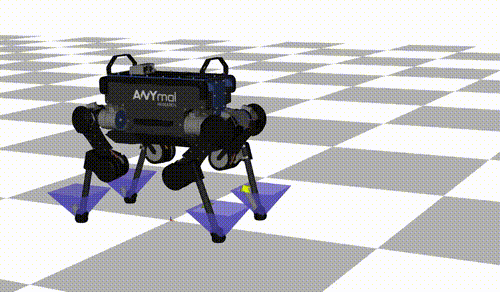This page explains the example code in examples/anymal/jump.cpp.

Required header files are as follows.
#include <string>
#include <memory>
#include "Eigen/Core"
int main(int argc, char *argv[]) {
First, we define the robot model. We speficy the URDF path, base joint type, and contact frames (in this case, the contact frames are the frames of all feet).
model_info.
urdf_path =
"../anymal_b_simple_description/urdf/anymal.urdf";
const double baumgarte_time_step = 0.04;
Dynamics and kinematics model of robots. Wraps pinocchio::Model and pinocchio::Data....
Definition: robot.hpp:32
Info of a robot model.
Definition: robot_model_info.hpp:24
std::vector< ContactModelInfo > point_contacts
Info of point contacts.
Definition: robot_model_info.hpp:83
BaseJointType base_joint_type
Type of the base joint. Default is BaseJointType::FixedBase.
Definition: robot_model_info.hpp:78
std::string urdf_path
Path to the URDF file.
Definition: robot_model_info.hpp:73
- Note
baumgarte_time_step is the stabilization parameter for acceleration-level rigid contact constraints. The best choice of baumgarte_time_step may be the time step of the optimal control problem. However, it is often too small to make the optimization problem high nonlinear. A moderate value such as several times of the time step of optimal control problem may be sufficient
Then set the parameters for the optimal control problem of the jump motion such as the jump length
const double dt = 0.01;
const Eigen::Vector3d jump_length = {0.5, 0, 0};
const double jump_height = 0.1;
const double flying_up_time = 0.15;
const double flying_down_time = flying_up_time;
const double flying_time = flying_up_time + flying_down_time;
const double ground_time = 0.30;
const double t0 = 0;
Next, we construct the cost function (TODO: write details about the cost function components).
auto cost = std::make_shared<robotoc::CostFunction>();
Eigen::VectorXd q_standing(Eigen::VectorXd::Zero(robot.dimq()));
q_standing << 0, 0, 0.4792, 0, 0, 0, 1,
-0.1, 0.7, -1.0,
-0.1, -0.7, 1.0,
0.1, 0.7, -1.0,
0.1, -0.7, 1.0;
Eigen::VectorXd q_weight(Eigen::VectorXd::Zero(robot.dimv()));
q_weight << 0, 0, 0, 250000, 250000, 250000,
0.0001, 0.0001, 0.0001,
0.0001, 0.0001, 0.0001,
0.0001, 0.0001, 0.0001,
0.0001, 0.0001, 0.0001;
Eigen::VectorXd v_weight(Eigen::VectorXd::Zero(robot.dimv()));
v_weight << 100, 100, 100, 100, 100, 100,
1, 1, 1,
1, 1, 1,
1, 1, 1,
1, 1, 1;
Eigen::VectorXd u_weight = Eigen::VectorXd::Constant(robot.dimu(), 1e-01);
Eigen::VectorXd q_weight_impact(Eigen::VectorXd::Zero(robot.dimv()));
q_weight_impact << 1, 1, 1, 1, 1, 1,
100, 100, 100,
100, 100, 100,
100, 100, 100,
100, 100, 100;
Eigen::VectorXd v_weight_impact = Eigen::VectorXd::Constant(robot.dimv(), 100);
auto config_cost = std::make_shared<robotoc::ConfigurationSpaceCost>(robot);
config_cost->set_q_ref(q_standing);
config_cost->set_q_weight(q_weight);
config_cost->set_q_weight_terminal(q_weight);
config_cost->set_q_weight_impact(q_weight_impact);
config_cost->set_v_weight(v_weight);
config_cost->set_v_weight_terminal(v_weight);
config_cost->set_v_weight_impact(v_weight_impact);
config_cost->set_u_weight(u_weight);
cost->add("config_cost", config_cost);
robot.updateFrameKinematics(q_standing);
const Eigen::Vector3d x3d0_LF = robot.framePosition("LF_FOOT");
const Eigen::Vector3d x3d0_LH = robot.framePosition("LH_FOOT");
const Eigen::Vector3d x3d0_RF = robot.framePosition("RF_FOOT");
const Eigen::Vector3d x3d0_RH = robot.framePosition("RH_FOOT");
const Eigen::Vector3d com_ref0_flying_up = robot.CoM();
const Eigen::Vector3d vcom_ref_flying_up = 0.5*jump_length/flying_up_time
+ Eigen::Vector3d({0, 0, jump_height/flying_up_time});
auto com_ref_flying_up = std::make_shared<robotoc::PeriodicCoMRef>(com_ref0_flying_up, vcom_ref_flying_up,
t0+ground_time, flying_up_time,
flying_down_time+2*ground_time, false);
auto com_cost_flying_up = std::make_shared<robotoc::CoMCost>(robot, com_ref_flying_up);
com_cost_flying_up->set_weight(Eigen::Vector3d::Constant(1.0e06));
cost->add("com_cost_flying_up", com_cost_flying_up);
const Eigen::Vector3d com_ref0_landed = robot.CoM() + jump_length;
const Eigen::Vector3d vcom_ref_landed = Eigen::Vector3d::Zero();
auto com_ref_landed = std::make_shared<robotoc::PeriodicCoMRef>(com_ref0_landed, vcom_ref_landed,
t0+ground_time+flying_time, ground_time,
ground_time+flying_time, false);
auto com_cost_landed = std::make_shared<robotoc::CoMCost>(robot, com_ref_landed);
com_cost_landed->set_weight(Eigen::Vector3d::Constant(1.0e06));
cost->add("com_cost_landed", com_cost_landed);
Next, we construct the constraints.
const double barrier_param = 1.0e-03;
const double fraction_to_boundary_rule = 0.995;
auto constraints = std::make_shared<robotoc::Constraints>(barrier_param, fraction_to_boundary_rule);
auto joint_position_lower = std::make_shared<robotoc::JointPositionLowerLimit>(robot);
auto joint_position_upper = std::make_shared<robotoc::JointPositionUpperLimit>(robot);
auto joint_velocity_lower = std::make_shared<robotoc::JointVelocityLowerLimit>(robot);
auto joint_velocity_upper = std::make_shared<robotoc::JointVelocityUpperLimit>(robot);
auto joint_torques_lower = std::make_shared<robotoc::JointTorquesLowerLimit>(robot);
auto joint_torques_upper = std::make_shared<robotoc::JointTorquesUpperLimit>(robot);
auto friction_cone = std::make_shared<robotoc::FrictionCone>(robot);
constraints->add("joint_position_lower", joint_position_lower);
constraints->add("joint_position_upper", joint_position_upper);
constraints->add("joint_velocity_lower", joint_velocity_lower);
constraints->add("joint_velocity_upper", joint_velocity_upper);
constraints->add("joint_torques_lower", joint_torques_lower);
constraints->add("joint_torques_upper", joint_torques_upper);
constraints->add("friction_cone", friction_cone);
Next, we construct the contact sequence robotoc::ContactSequence as
auto contact_sequence = std::make_shared<robotoc::ContactSequence>(robot);
We set the contact positions and friction coefficients through the contact sequence. We then define the friction coefficients.
const double mu = 0.7;
const std::unordered_map<std::string, double> friction_coefficients = {{"LF_FOOT", mu},
{"LH_FOOT", mu},
{"RF_FOOT", mu},
{"RH_FOOT", mu}};
We set the initial contact status of the robot. In the beginning, the robot is standing, so all the contacts are active.
std::unordered_map<std::string, Eigen::Vector3d> contact_positions = {{"LF_FOOT", x3d0_LF},
{"LH_FOOT", x3d0_LH},
{"RF_FOOT", x3d0_RF},
{"RH_FOOT", x3d0_RH}};
auto contact_status_standing = robot.createContactStatus();
contact_status_standing.activateContacts(std::vector<std::string>({"LF_FOOT", "LH_FOOT", "RF_FOOT", "RH_FOOT"}));
contact_status_standing.setContactPlacements(contact_positions);
contact_status_standing.setFrictionCoefficients(friction_coefficients);
contact_sequence->init(contact_status_standing);
Next, we set the contact status when the robot is flying. Then the all the contacts are inactive.
auto contact_status_flying = robot.createContactStatus();
contact_sequence->push_back(contact_status_flying, t0+ground_time);
Then a lift event is automatically appended into the contact sequence. Finally, we set the contact status after touch-down as
contact_positions["LF_FOOT"].noalias() += jump_length;
contact_positions["LH_FOOT"].noalias() += jump_length;
contact_positions["RF_FOOT"].noalias() += jump_length;
contact_positions["RH_FOOT"].noalias() += jump_length;
contact_status_standing.setContactPlacements(contact_positions);
contact_sequence->push_back(contact_status_standing,
t0+ground_time+flying_time);
Then an impact event is automatically appended into the contact sequence.
- Note
- We can check the contact sequence via
std::cout << contact_sequence << std::endl;
Finally, we can construct the optimal control solver!
const double T = t0 + flying_time + 2 * ground_time;
const int N = T / dt;
robotoc::OCP ocp(robot, cost, constraints, contact_sequence, T, N);
solver_options.nthreads = 4;
Optimal control problem solver by Riccati recursion.
Definition: ocp_solver.hpp:41
The optimal control problem.
Definition: ocp.hpp:22
Options of optimal control solvers.
Definition: solver_options.hpp:17
Let's run the solver!
const double t = 0;
const Eigen::VectorXd q(q_standing);
const Eigen::VectorXd v(Eigen::VectorXd::Zero(robot.dimv()));
ocp_solver.discretize(t);
ocp_solver.setSolution("q", q);
ocp_solver.setSolution("v", v);
Eigen::Vector3d f_init;
f_init << 0, 0, 0.25*robot.totalWeight();
ocp_solver.setSolution("f", f_init);
ocp_solver.initConstraints();
std::cout << "Initial KKT error: " << ocp_solver.KKTError(t, q, v) << std::endl;
ocp_solver.solve(t, q, v);
std::cout << "KKT error after convergence: " << ocp_solver.KKTError(t, q, v) << std::endl;
std::cout << ocp_solver.getSolverStatistics() << std::endl;
return 0;
}
- Note
- We can check the discretization of the optimal control problem sololy via
time_discretization.discretize(contact_sequence, t);
std::cout << time_discretization << std::endl;
Time discretization of the optimal control problem.
Definition: time_discretization.hpp:20
